Abstract
1 To assess the potential hazards of nitrazepam therapy of insomnia in the elderly, adverse reactions to nitrazepam were studied in 2111 hospitalized medical patients who received the drug. 2 Manifestations of unwanted central nervous system (CNS) depression (such as drowsiness or 'hangover') were reported in 49 nitrazepam recipients (2.3%), and signs of unwanted CNS stimulation (such as nightmares, insomnia, agitation, etc.) in 15 (0.7%). None of the adverse reactions were considered serious. 3 Physician-rated clinical efficacy of nitrazepam was not related to dose, but the frequency of both types of adverse reactions increased significantly at higher daily doses. CNS depression also was significantly more frequent in the elderly, being reported in 11% of those aged 80 years or older, whereas the frequency of CNS stimulation was not correlated with age. 4 The effect of age on the reported rate of unwanted CNS depression was most striking at high doses. Among patients aged 80 years or over whose daily dose averaged 10 mg or more, 55% experienced unwanted CNS depression attributed to nitrazepam. 5 Low doses of nitrazepam are safe for elderly individuals, but the elderly are readily susceptible to excessive CNS depression at high doses. The findings suggest that there is little reason to exceed 5mg doses of nitrazepam for most patients, particularly those who are elderly.
Full text
PDF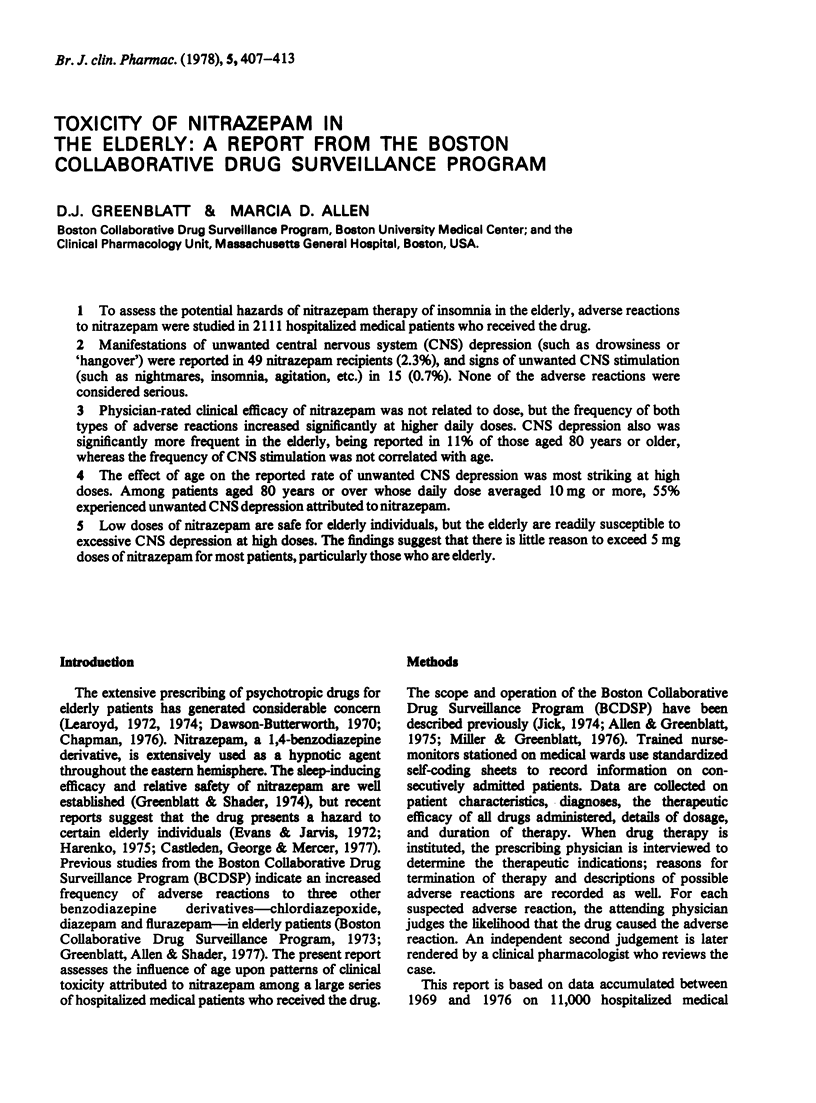
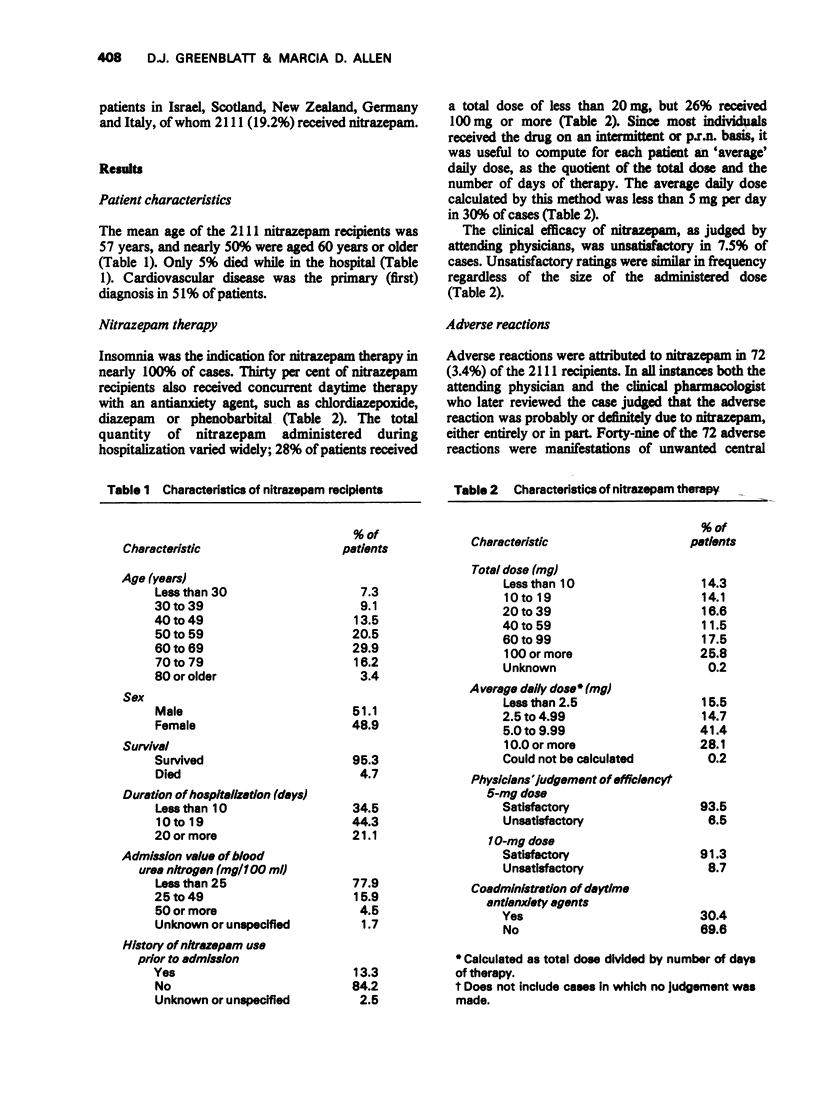
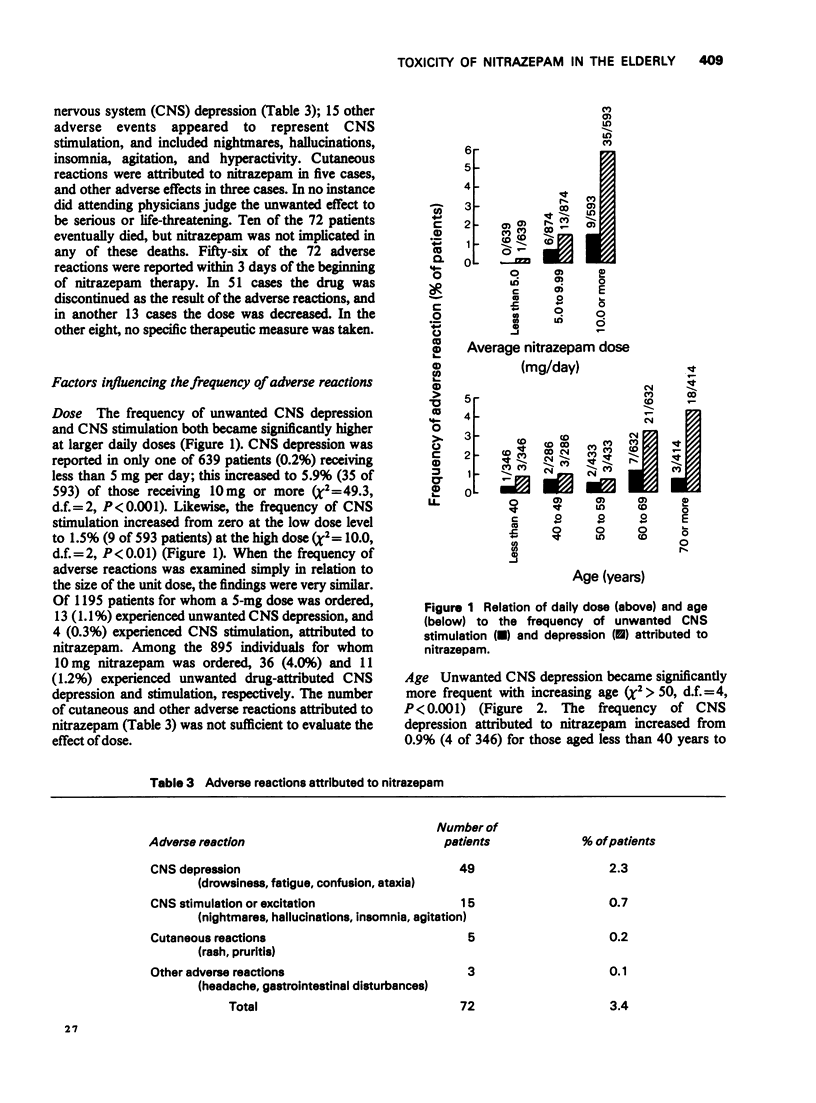
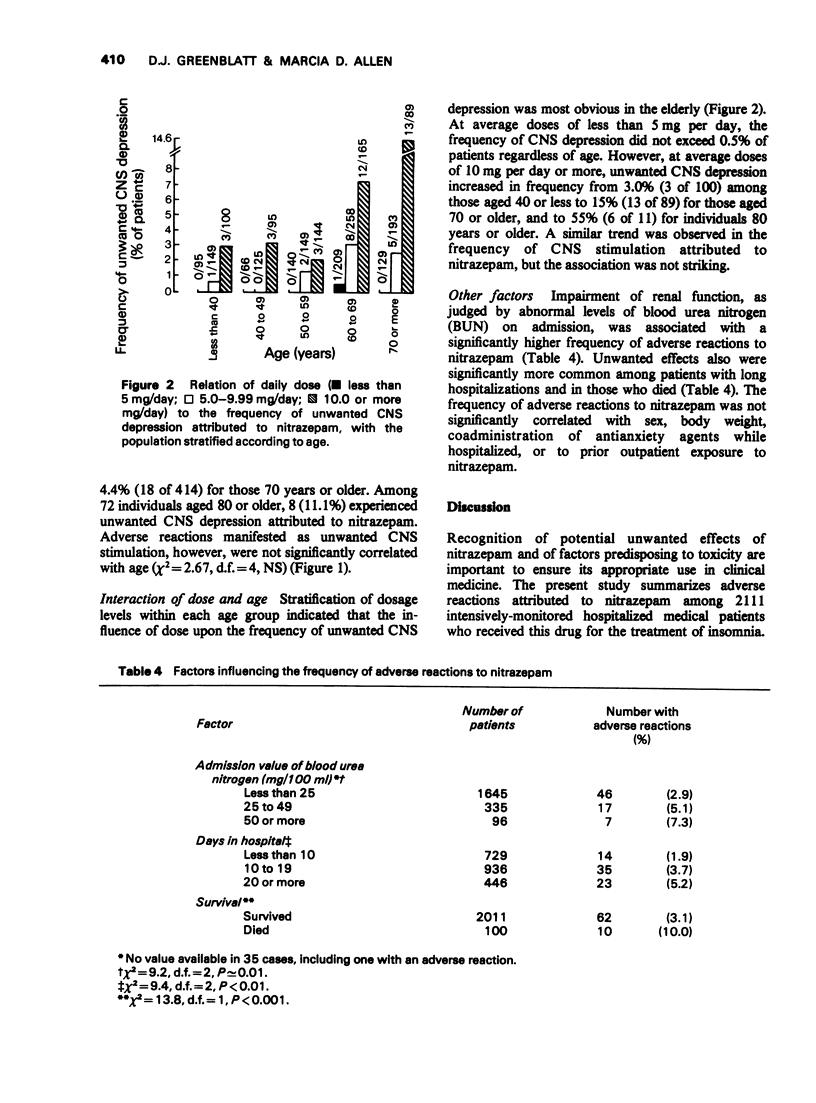
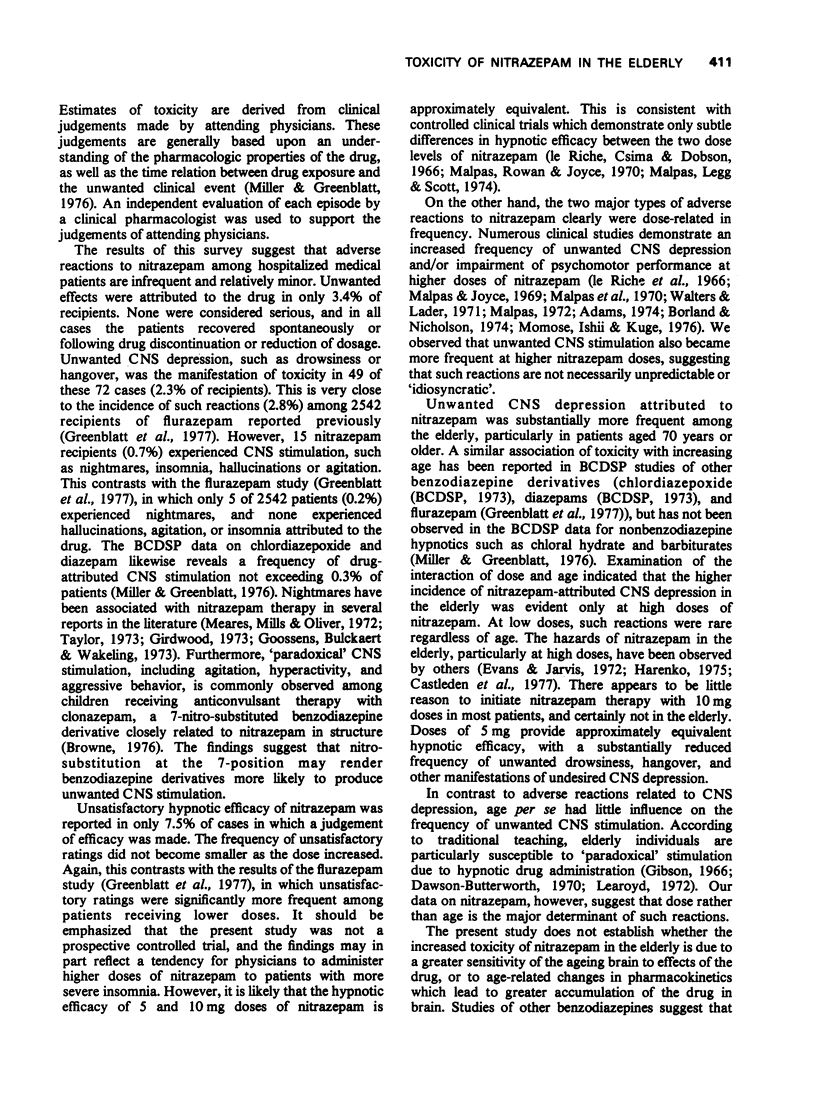
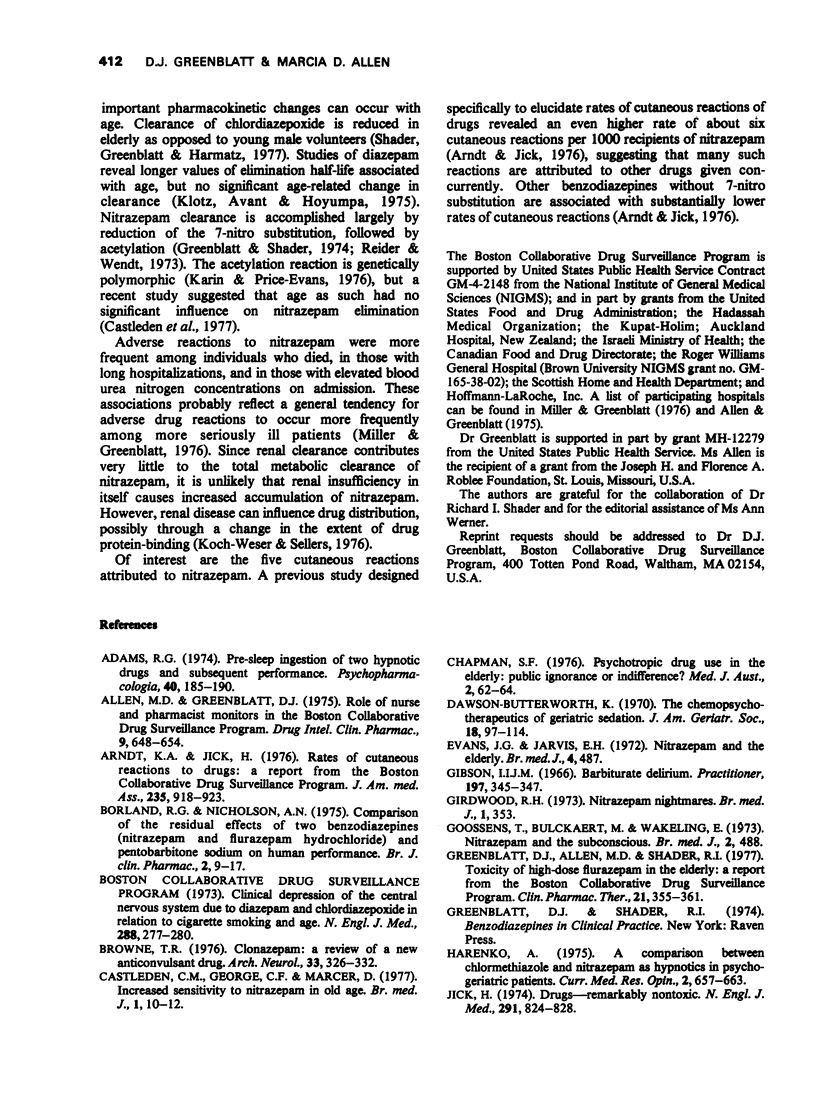
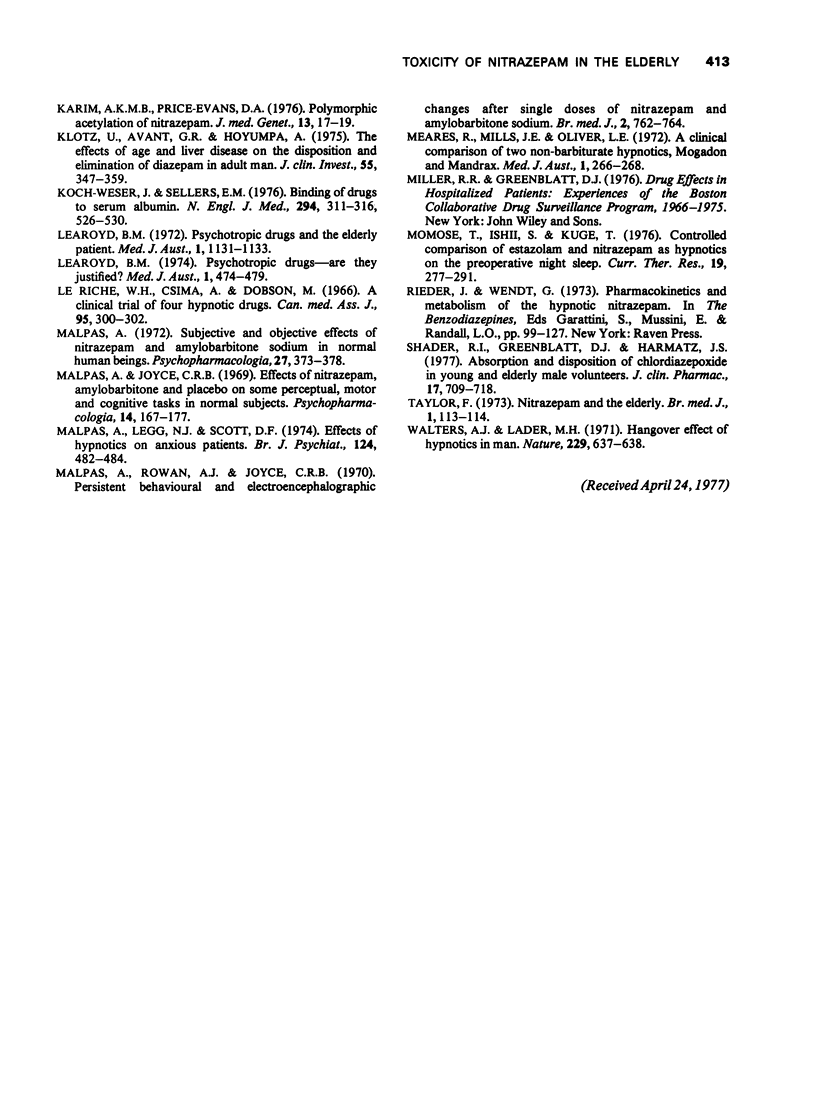
Selected References
These references are in PubMed. This may not be the complete list of references from this article.
- Adams R. G. Pre-sleep ingestion of two hypnotic drugs and subsequent perfomance. Psychopharmacologia. 1974;40(2):185–190. doi: 10.1007/BF00421369. [DOI] [PubMed] [Google Scholar]
- Allen M. D., Greenblatt D. J. Role of nurse and pharmacist monitors in the Boston Collaborative Drug Surveillance Program. Drug Intell Clin Pharm. 1975 Dec;9(12):648–654. doi: 10.1177/106002807500901202. [DOI] [PubMed] [Google Scholar]
- Arndt K. A., Jick H. Rates of cutaneous reactions to drugs. A report from the Boston Collaborative Drug Surveillance Program. JAMA. 1976 Mar 1;235(9):918–923. [PubMed] [Google Scholar]
- Borland R. G., Nicholson A. N. Comparison of the residual effects of two benzodiazepines (nitrazepam and flurazepam hydrochloride) and pentobarbitone sodium on human performance. Br J Clin Pharmacol. 1975 Feb;2(1):9–17. doi: 10.1111/j.1365-2125.1975.tb00465.x. [DOI] [PMC free article] [PubMed] [Google Scholar]
- Browne T. R. Clonazepam. A review of a new anticonvulsant drug. Arch Neurol. 1976 May;33(5):326–332. doi: 10.1001/archneur.1976.00500050012003. [DOI] [PubMed] [Google Scholar]
- Castleden C. M., George C. F., Marcer D., Hallett C. Increased sensitivity to nitrazepam in old age. Br Med J. 1977 Jan 1;1(6052):10–12. doi: 10.1136/bmj.1.6052.10. [DOI] [PMC free article] [PubMed] [Google Scholar]
- Chapman S. F. Psychotropic drug use in the elderly. Public ignorance or indifference? Med J Aust. 1976 Jul 10;2(2):62–64. [PubMed] [Google Scholar]
- Evans J. G., Jarvis E. H. Nitrazepam and the elderly. Br Med J. 1972 Nov 25;4(5838):487–487. doi: 10.1136/bmj.4.5838.487-a. [DOI] [PMC free article] [PubMed] [Google Scholar]
- Gibson I. I. Barbiturate delirium. Practitioner. 1966 Sep;197(179):345–347. [PubMed] [Google Scholar]
- Goossens T., Bulckaert M., Wakeling E. Nitrazepam and the subconscious. Br Med J. 1973 May 26;2(5864):488–488. doi: 10.1136/bmj.2.5864.488. [DOI] [PMC free article] [PubMed] [Google Scholar]
- Greenblatt D. J., Allen M. D., Shader R. I. Toxicity of high-dose flurazepam in the elderly. Clin Pharmacol Ther. 1977 Mar;21(3):355–361. doi: 10.1002/cpt1977213355. [DOI] [PubMed] [Google Scholar]
- Harenko A. A comparison between chlormethiazole and nitrazepam as hypnotics in psycho-geriatric patients. Curr Med Res Opin. 1974;2(10):657–663. doi: 10.1185/03007997409111879. [DOI] [PubMed] [Google Scholar]
- Jick H. Drugs--remarkably nontoxic. N Engl J Med. 1974 Oct 17;291(16):824–828. doi: 10.1056/NEJM197410172911605. [DOI] [PubMed] [Google Scholar]
- Karim A. K., Evans D. A. Polymorphic acetylation of nitrazepam. J Med Genet. 1976 Feb;13(1):17–19. doi: 10.1136/jmg.13.1.17. [DOI] [PMC free article] [PubMed] [Google Scholar]
- Klotz U., Avant G. R., Hoyumpa A., Schenker S., Wilkinson G. R. The effects of age and liver disease on the disposition and elimination of diazepam in adult man. J Clin Invest. 1975 Feb;55(2):347–359. doi: 10.1172/JCI107938. [DOI] [PMC free article] [PubMed] [Google Scholar]
- Koch-Weser J., Sellers E. M. Binding of drugs to serum albumin (first of two parts). N Engl J Med. 1976 Feb 5;294(6):311–316. doi: 10.1056/NEJM197602052940605. [DOI] [PubMed] [Google Scholar]
- Learoyd B. M. Psychotropic drugs and the elderly patient. Med J Aust. 1972 May 27;1(22):1131–1133. [PubMed] [Google Scholar]
- Learoyd B. M. Psychotropic drugs--are they justified? Med J Aust. 1974 Mar 30;1(13):474–479. [PubMed] [Google Scholar]
- Malpas A., Joyce C. R. Effects of nitrazepam, amylobarbitone and placebo on some perceptual, motor and cognitive tasks in normal subjects. Psychopharmacologia. 1969;14(3):167–177. doi: 10.1007/BF00404214. [DOI] [PubMed] [Google Scholar]
- Malpas A., Legg N. J., Scott D. F. Effects of hypnotics on anxious patients. Br J Psychiatry. 1974 May;124(0):482–484. doi: 10.1192/bjp.124.5.482. [DOI] [PubMed] [Google Scholar]
- Malpas A., Rowan A. J., Boyce C. R., Scott D. F. Persistent behavioural and electroencephalographic changes after single doses of nitrazepam and amylobarbitone sodium. Br Med J. 1970 Jun 27;2(5712):762–764. doi: 10.1136/bmj.2.5712.762. [DOI] [PMC free article] [PubMed] [Google Scholar]
- Malpas A. Subjective and objective effects of nitrazepam and amylobarbitone sodium in normal human beings. Psychopharmacologia. 1972;27(4):373–378. doi: 10.1007/BF00429391. [DOI] [PubMed] [Google Scholar]
- Meares R., Mills J. E., Oliver L. E. A clinical comparison of two non-barbiturate hypnotics, mogadon and mandrax. Med J Aust. 1972 Feb 5;1(6):266–268. doi: 10.5694/j.1326-5377.1972.tb50915.x. [DOI] [PubMed] [Google Scholar]
- Momose T. Controlled comparison of estazolam and nitrazepam as hypnotics on the preoperative night sleep. Curr Ther Res Clin Exp. 1976 Mar;19(3):277–291. [PubMed] [Google Scholar]
- Shader R. I., Greenblatt D. J., Harmatz J. S., Franke K., Koch-Weser J. Absorption and disposition of chlordiazepoxide in young and elderly male volunteers. J Clin Pharmacol. 1977 Nov-Dec;17(11-12):709–718. doi: 10.1002/j.1552-4604.1977.tb01546.x. [DOI] [PubMed] [Google Scholar]
- Walters A. J., Lader M. H. Hangover effect of hypnotics in man. Nature. 1971 Feb 26;229(5287):637–638. doi: 10.1038/229637b0. [DOI] [PubMed] [Google Scholar]
- le Riche W. H., Csima A., Dobson M. A clinical trial of four hypnotic drugs. Can Med Assoc J. 1966 Aug 13;95(7):300–302. [PMC free article] [PubMed] [Google Scholar]


